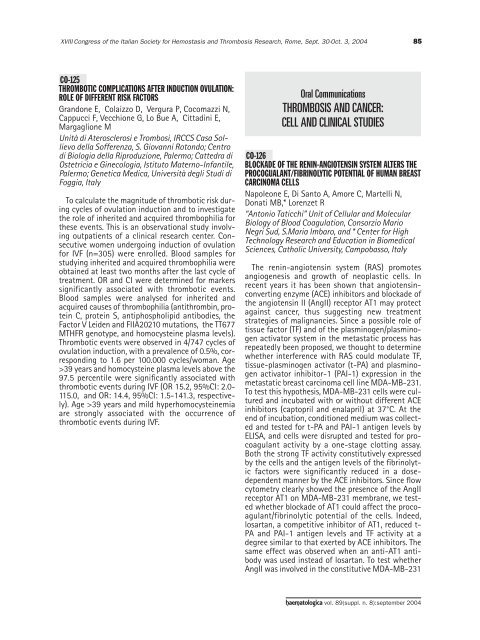Haematologica 2004;89: supplement no. 8 - Supplements ...
Haematologica 2004;89: supplement no. 8 - Supplements ...
Haematologica 2004;89: supplement no. 8 - Supplements ...
- No tags were found...
You also want an ePaper? Increase the reach of your titles
YUMPU automatically turns print PDFs into web optimized ePapers that Google loves.
XVIII Congress of the Italian Society for Hemostasis and Thrombosis Research, Rome, Sept. 30-Oct. 3, <strong>2004</strong>85CO-125THROMBOTIC COMPLICATIONS AFTER INDUCTION OVULATION:ROLE OF DIFFERENT RISK FACTORSGrandone E, Colaizzo D, Vergura P, Cocomazzi N,Cappucci F, Vecchione G, Lo Bue A, Cittadini E,Margaglione MUnità di Aterosclerosi e Trombosi, IRCCS Casa Sollievodella Sofferenza, S. Giovanni Rotondo; Centrodi Biologia della Riproduzione, Palermo; Cattedra diOstetricia e Ginecologia, Istituto Mater<strong>no</strong>-Infantile,Palermo; Genetica Medica, Università degli Studi diFoggia, ItalyTo calculate the magnitude of thrombotic risk duringcycles of ovulation induction and to investigatethe role of inherited and acquired thrombophilia forthese events. This is an observational study involvingoutpatients of a clinical research center. Consecutivewomen undergoing induction of ovulationfor IVF (n=305) were enrolled. Blood samples forstudying inherited and acquired thrombophilia wereobtained at least two months after the last cycle oftreatment. OR and CI were determined for markerssignificantly associated with thrombotic events.Blood samples were analysed for inherited andacquired causes of thrombophilia (antithrombin, proteinC, protein S, antiphospholipid antibodies, theFactor V Leiden and FIIA20210 mutations, the TT677MTHFR ge<strong>no</strong>type, and homocysteine plasma levels).Thrombotic events were observed in 4/747 cycles ofovulation induction, with a prevalence of 0.5%, correspondingto 1.6 per 100.000 cycles/woman. Age>39 years and homocysteine plasma levels above the97.5 percentile were significantly associated withthrombotic events during IVF (OR 15.2, 95%CI: 2.0-115.0, and OR: 14.4, 95%CI: 1.5-141.3, respectively).Age >39 years and mild hyperhomocysteinemiaare strongly associated with the occurrence ofthrombotic events during IVF.Oral CommunicationsTHROMBOSIS AND CANCER:CELL AND CLINICAL STUDIESCO-126BLOCKADE OF THE RENIN-ANGIOTENSIN SYSTEM ALTERS THEPROCOGUALANT/FIBRINOLYTIC POTENTIAL OF HUMAN BREASTCARCINOMA CELLSNapoleone E, Di Santo A, Amore C, Martelli N,Donati MB,* Lorenzet R“Antonio Taticchi” Unit of Cellular and MolecularBiology of Blood Coagulation, Consorzio MarioNegri Sud, S.Maria Imbaro, and * Center for HighTech<strong>no</strong>logy Research and Education in BiomedicalSciences, Catholic University, Campobasso, ItalyThe renin-angiotensin system (RAS) promotesangiogenesis and growth of neoplastic cells. Inrecent years it has been shown that angiotensinconvertingenzyme (ACE) inhibitors and blockade ofthe angiotensin II (AngII) receptor AT1 may protectagainst cancer, thus suggesting new treatmentstrategies of malignancies. Since a possible role oftissue factor (TF) and of the plasmi<strong>no</strong>gen/plasmi<strong>no</strong>genactivator system in the metastatic process hasrepeatedly been proposed, we thought to determinewhether interference with RAS could modulate TF,tissue-plasmi<strong>no</strong>gen activator (t-PA) and plasmi<strong>no</strong>genactivator inhibitor-1 (PAI-1) expression in themetastatic breast carci<strong>no</strong>ma cell line MDA-MB-231.To test this hypothesis, MDA-MB-231 cells were culturedand incubated with or without different ACEinhibitors (captopril and enalapril) at 37°C. At theend of incubation, conditioned medium was collectedand tested for t-PA and PAI-1 antigen levels byELISA, and cells were disrupted and tested for procoagulantactivity by a one-stage clotting assay.Both the strong TF activity constitutively expressedby the cells and the antigen levels of the fibri<strong>no</strong>lyticfactors were significantly reduced in a dosedependentmanner by the ACE inhibitors. Since flowcytometry clearly showed the presence of the AngIIreceptor AT1 on MDA-MB-231 membrane, we testedwhether blockade of AT1 could affect the procoagulant/fibri<strong>no</strong>lyticpotential of the cells. Indeed,losartan, a competitive inhibitor of AT1, reduced t-PA and PAI-1 antigen levels and TF activity at adegree similar to that exerted by ACE inhibitors. Thesame effect was observed when an anti-AT1 antibodywas used instead of losartan. To test whetherAngII was involved in the constitutive MDA-MB-231haematologica vol. <strong>89</strong>(suppl. n. 8):september <strong>2004</strong>
















